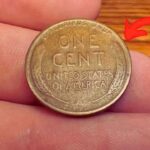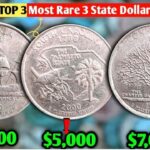In the fascinating world of coin collecting, few coins spark as much intrigue and admiration as the Lincoln Wheat Penny. First minted in 1909 to honor President Abraham Lincoln’s 100th birthday, this iconic American cent was the first U.S. coin to feature a real historical figure. Since then, it has gained legendary status among collectors and history enthusiasts alike. Some rare variations, like the 1943 bronze version, are now valued at astonishing figures—even up to $1.5 million.
A Historic Tribute to Lincoln
The Lincoln Wheat Penny, affectionately known as the “Wheatie,” was designed by Victor D. Brenner. On the obverse, it features a detailed portrait of Abraham Lincoln, while the reverse displays two wheat ears bordering the words “ONE CENT.” This design remained in circulation until 1958, symbolizing resilience through the Great Depression and two World Wars. The Lincoln Wheat Penny is more than just currency—it’s a tangible piece of American heritage.
Composition and War-Time Changes
From 1909 to 1982, U.S. pennies were primarily composed of copper. But during World War II, copper was needed for military equipment, leading to a pivotal change in 1943. That year, the U.S. Mint produced pennies using zinc-coated steel. These silver-gray coins stand out among their bronze counterparts and have become a key focus for collectors.
But here’s where things get truly exciting: a few 1943 Lincoln Wheat Pennies were mistakenly struck on leftover bronze planchets from 1942. These error coins are extremely rare and fetch jaw-dropping prices at auctions.
The $1.5 Million Lincoln Wheat Penny
Among the most valuable of these error coins is a 1943 bronze Lincoln Wheat Penny estimated to be worth up to $1.5 million. Here’s why:
- Wrong Metal Composition: The Mint intended to strike all 1943 pennies in steel. Bronze planchets slipping through the system created a historic mistake.
- Extreme Rarity: Fewer than 20 of these error coins are known to exist.
- Authenticated Value: Verified by professional grading services like PCGS or NGC, these coins can fetch top dollar depending on condition.
Is the Million-Dollar Penny Still Out There?
Absolutely—and that’s what keeps collectors excited. Stories abound of people finding rare Lincoln Wheat Pennies in old jars, inherited coin collections, and even everyday pocket change. This fuels the dream that a million-dollar penny might still be in someone’s possession without their knowledge.
Also Read – Yamaha R15 के नए लुक के दीवाने हो रहे भारतीय लोग, 55kmpl शानदार माइलेज के साथ देखे फीचर्स और कीमत
How to Spot a 1943 Bronze Lincoln Wheat Penny
Want to try your luck? Here’s how to identify the elusive bronze 1943 Lincoln Wheat Penny:
- Check the Date: Look for 1943 pennies that are copper-colored rather than silver.
- Magnet Test: Steel pennies stick to magnets. Bronze ones do not.
- Examine the Color: Bronze has a reddish-brown hue. Steel appears grayish.
- Weigh It: Bronze pennies weigh about 3.11 grams; steel ones weigh around 2.7 grams.
- Authenticate It: If you suspect you have a rare penny, have it graded by PCGS or NGC.
Beware of Counterfeits
With such high values at stake, counterfeit Lincoln Wheat Pennies are common. Some fakes are 1948 pennies altered to look like 1943. Always use a reputable dealer or get professional verification when buying or selling high-value coins.
Other Rare Lincoln Wheat Pennies Worth Collecting
The 1943 bronze penny may be the crown jewel, but several other Lincoln Wheat Pennies are also highly prized:
- 1909-S VDB: The first issue, minted in San Francisco, with designer Brenner’s initials on the reverse.
- 1914-D: A rare Denver-minted coin that can fetch thousands.
- 1922 No D: An error coin missing the Denver mintmark.
- 1955 Doubled Die: Features a visibly doubled date and lettering.
These coins all add rich layers to a Lincoln Wheat Penny collection.
Getting Started With Lincoln Wheat Penny Collecting
If you’re new to collecting, Lincoln Wheat Pennies offer an accessible and exciting entry point:
- Search Coin Rolls: Ask your bank for penny rolls and hunt for treasures.
- Start a Coin Album: Use folders made specifically for Lincoln pennies.
- Study the Market: Learn mintmarks, error types, and grading scales.
- Join Communities: Engage in online forums and local coin clubs to share tips and stories.
Final Thoughts
The Lincoln Wheat Penny represents more than just one cent—it’s a journey through American history, a collector’s challenge, and perhaps even a hidden fortune. Whether you’re a casual hobbyist or a serious numismatist, the thrill of uncovering a rare penny keeps the passion alive.
So next time you get change at the store, don’t dismiss that old-looking penny. It might just be the Lincoln Wheat Penny that unlocks a million-dollar mystery.
FAQs About Lincoln Wheat Pennies
1. What is a Lincoln Wheat Penny?
A U.S. one-cent coin minted from 1909 to 1958, featuring Abraham Lincoln and wheat ears on the reverse.
2. Why is the 1943 bronze penny so valuable?
Because it’s a rare minting error from a year when pennies were intended to be made of steel.
3. How can I identify a rare Lincoln Wheat Penny?
Check the year, use a magnet, weigh the coin, and look for signs of authenticity.
4. Are all Lincoln Wheat Pennies valuable?
Not all, but many pre-1930s and error coins can be worth significant amounts depending on condition.
5. Where can I sell one?
Trusted coin dealers, auction houses, and online marketplaces—especially for authenticated coins.
Some Important Link
| Telegram Group | Click Here |
| WhatsApp Group | Click Here |
| Home Page | Click Here |










